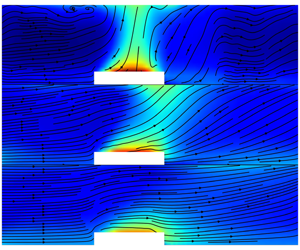Crossref Citations
This article has been cited by the following publications. This list is generated based on data provided by
Crossref.
Bou-Zeid, Elie
Anderson, William
Katul, Gabriel G.
and
Mahrt, Larry
2020.
The Persistent Challenge of Surface Heterogeneity in Boundary-Layer Meteorology: A Review.
Boundary-Layer Meteorology,
Vol. 177,
Issue. 2-3,
p.
227.
Sharma, Ashish
Wuebbles, Donald J.
and
Kotamarthi, Rao
2021.
The Need for Urban‐Resolving Climate Modeling Across Scales.
AGU Advances,
Vol. 2,
Issue. 1,
Hertwig, Denise
Ng, Matthew
Grimmond, Sue
Vidale, Pier Luigi
and
McGuire, Patrick C.
2021.
High‐resolution global climate simulations: Representation of cities.
International Journal of Climatology,
Vol. 41,
Issue. 5,
p.
3266.
Cui, Yuanfeng
Hu, Leiqiu
Wang, Zhihua
and
Li, Qi
2021.
Urban nocturnal cooling mediated by bluespace.
Theoretical and Applied Climatology,
Vol. 146,
Issue. 1-2,
p.
277.
Du, Bowen
Ge, Mingwei
Zeng, Chongji
Cui, Guixiang
and
Liu, Yongqian
2021.
Influence of atmospheric stability on wind-turbine wakes with a certain hub-height turbulence intensity.
Physics of Fluids,
Vol. 33,
Issue. 5,
Inam, Saad
and
Lappa, Marcello
2022.
Hybrid forced-buoyancy convection in a channel with a backward facing step.
International Journal of Heat and Mass Transfer,
Vol. 194,
Issue. ,
p.
122963.
Theeuwes, Natalie E.
Boutle, Ian A.
Clark, Peter A.
and
Grimmond, Sue
2022.
Understanding London's summertime cloud cover.
Quarterly Journal of the Royal Meteorological Society,
Vol. 148,
Issue. 742,
p.
454.
Xu, Ao
Xu, Ben-Rui
Jiang, Li-Sheng
and
Xi, Heng-Dong
2022.
Production and transport of vorticity in two-dimensional Rayleigh–Bénard convection cell.
Physics of Fluids,
Vol. 34,
Issue. 1,
Qian, Yun
Chakraborty, T. C.
Li, Jianfeng
Li, Dan
He, Cenlin
Sarangi, Chandan
Chen, Fei
Yang, Xuchao
and
Leung, L. Ruby
2022.
Urbanization Impact on Regional Climate and Extreme Weather: Current Understanding, Uncertainties, and Future Research Directions.
Advances in Atmospheric Sciences,
Vol. 39,
Issue. 6,
p.
819.
Zhang, Ziyan
Paschalis, Athanasios
Mijic, Ana
Meili, Naika
Manoli, Gabriele
van Reeuwijk, Maarten
and
Fatichi, Simone
2022.
A mechanistic assessment of urban heat island intensities and drivers across climates.
Urban Climate,
Vol. 44,
Issue. ,
p.
101215.
Zeeman, Matthias
Holst, Christopher Claus
Kossmann, Meinolf
Leukauf, Daniel
Münkel, Christoph
Philipp, Andreas
Rinke, Rayk
and
Emeis, Stefan
2022.
Urban Atmospheric Boundary-Layer Structure in Complex Topography: An Empirical 3D Case Study for Stuttgart, Germany.
Frontiers in Earth Science,
Vol. 10,
Issue. ,
Fogarty, Joseph
and
Bou-Zeid, Elie
2023.
The Atmospheric Boundary Layer Above the Marginal Ice Zone: Scaling, Surface Fluxes, and Secondary Circulations.
Boundary-Layer Meteorology,
Vol. 189,
Issue. 1-3,
p.
53.
Zhou, Kangcheng
Liu, Chun-Ho
and
Wan, Minping
2023.
Large-scale coherent structure and canopy-level turbulence in the convective boundary layer over urban areas.
Building and Environment,
Vol. 244,
Issue. ,
p.
110733.
Vo, Thuy Trang
Hu, Leiqiu
Xue, Lulin
Li, Qi
and
Chen, Sisi
2023.
Urban effects on local cloud patterns.
Proceedings of the National Academy of Sciences,
Vol. 120,
Issue. 21,
Li, Weiyi
and
Giometto, Marco G.
2023.
Mean flow and turbulence in unsteady canopy layers.
Journal of Fluid Mechanics,
Vol. 974,
Issue. ,
Cui, Yuanfeng
Xiao, Shuolin
Giometto, Marco G.
and
Li, Qi
2023.
Effects of Urban Surface Roughness on Potential Sources of Microplastics in the Atmospheric Boundary Layer.
Boundary-Layer Meteorology,
Vol. 186,
Issue. 3,
p.
425.
Hora, Gurpreet S.
and
Giometto, Marco G.
2024.
Surrogate modeling of urban boundary layer flows.
Physics of Fluids,
Vol. 36,
Issue. 7,
Sato, Takuto
Hino, Hideitsu
and
Kusaka, Hiroyuki
2024.
Separating urban heat island circulation and convective cells through dynamic mode decomposition.
Atmospheric Science Letters,
Vol. 25,
Issue. 12,
Fogarty, Joseph
Bou-Zeid, Elie
Bushuk, Mitchell
and
Boisvert, Linette
2024.
How many parameters are needed to represent polar sea ice surface patterns and heterogeneity?.
The Cryosphere,
Vol. 18,
Issue. 9,
p.
4335.
Stein-Montalvo, Lucia
Ding, Liuyang
Hultmark, Marcus
Adriaenssens, Sigrid
and
Bou-Zeid, Elie
2024.
Kirigami-inspired wind steering for natural ventilation.
Journal of Wind Engineering and Industrial Aerodynamics,
Vol. 246,
Issue. ,
p.
105667.



